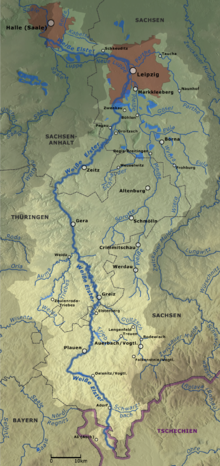White Elster
You can help expand this article with text translated from the corresponding article in German. (November 2022) Click [show] for important translation instructions.
|
| White Elster Weiße Elster, Bílý Halštrov | |
|---|---|
 White Elster valley near Wünschendorf/Elster | |
 | |
| Location | |
| Countries | |
| Physical characteristics | |
| Source | |
| • location | Hazlov, Karlovy Vary Region, Czech Republic |
| • elevation | 724 m (2,375 ft) |
| Mouth | |
• location | Saale |
• coordinates | 51°25′57″N 11°57′10″E / 51.43250°N 11.95278°E |
| Length | 257 km (160 mi) |
| Basin features | |
| Progression | Saale→ Elbe→ North Sea |
| Tributaries | |
| • left | Weida |
| • right | Schwarzbach, Trieb, Göltzsch, Schnauder, Pleiße, Parthe, Reide |
The White Elster[1][2][3] (German: Weiße Elster, Czech: Bílý Halštrov) is a 257-kilometre (160 mi) long river in central Europe. It is a right tributary of the Saale. The source of the White Elster is in the westernmost part of the Czech Republic, in the territory of Hazlov. After a few kilometres, it flows into eastern Germany where it cuts through the Vogtland in (according to the Encyclopædia Britannica) a "deep and picturesque valley".[4] In Germany it flows through the states of Saxony, Thuringia and Saxony-Anhalt. The White Elster flows through the cities of Plauen, Greiz, Gera, Zeitz, Pegau and Leipzig, and into the river Saale in Halle.
Name[edit]
Although "Elster" is German for "magpie", the origin of the name has nothing to do with the bird. The name comes from the Indo-European root el-/ol- meaning "flow" and the Germanic ending "-str". Alster has the same etymology.[5] The White Elster never meets the Black Elster, which flows from Lusatia into the River Elbe. The rivers have the names "white" and "black" to distinguish between them.
History[edit]
The White Elster proved disastrous to the French troops when they retreated from Leipzig in October 1813, as a part of the Napoleonic Wars.[2] Józef Poniatowski, Marshal of France, drowned in the river on 19 October 1813.
-
Source of the White Elster
See also[edit]
References[edit]
- ^ The "White Elster" river Archived 2011-09-27 at the Wayback Machine at www.germany-tourism.co.uk
- ^ a b Brookes, Richard and Marshall, John (1832). A new universal gazetteer: containing a description of the principal nations, W.W. Reed & Co,, New York, p. 270
- ^ White Elster from National Geospatial-Intelligence Agency, Bethesda, MD, USA. Accessed on 16 Jan 2011.
- ^ Chisholm, Hugh, ed. (1911). . Encyclopædia Britannica. Vol. 9 (11th ed.). Cambridge University Press. p. 300.
- ^ Jürgen Udolph: Namenkundliche Studien zum Germanenproblem, S. 245, Sieboldshausen 1993, oder Archived (Date missing) at eurasischesmagazin.de (Error: unknown archive URL), im Eurasischen Magazin, 26. März 2004
- White Elster
- Rivers of the Karlovy Vary Region
- Cheb District
- Rivers of Saxony
- Rivers of Saxony-Anhalt
- Rivers of Thuringia
- White Elster basin
- Rivers of Germany
- International rivers of Europe
- Saxony river stubs
- Thuringia river stubs
- Saxony-Anhalt river stubs
- Karlovy Vary Region geography stubs
- Czech Republic river stubs

